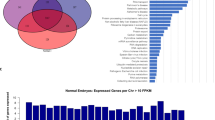Abstract
Microarrays represent a significant advantage when studying gene expression in early embryo because they allow for a speedy study of a large number of genes even if the sample of interest contains small quantities of genetic material. Here we describe the protocols developed by the EmbryoGENE Network to study the bovine transcriptome in early embryo using a microarray experimental design.
Access this chapter
Tax calculation will be finalised at checkout
Purchases are for personal use only
Similar content being viewed by others
References
Alexopoulos NI et al (2008) Developmental disparity between in vitro-produced and somatic cell nuclear transfer bovine days 14 and 21 embryos: implications for embryonic loss. (Translated from eng). Reproduction 136(4):433–445
Crosier AE, Farin PW, Dykstra MJ, Alexander JE, Farin CE (2001) Ultrastructural morphometry of bovine blastocysts produced in vivo or in vitro. (Translated from eng). Biol Reprod 64(5):1375–1385
McEvoy TG, Ashworth CJ, Rooke JA, Sinclair KD (2003) Consequences of manipulating gametes and embryos of ruminant species. (Translated from eng). Reprod Suppl 61:167–182
McEvoy TG, Sinclair KD, Young LE, Wilmut I, Robinson JJ (2000) Large offspring syndrome and other consequences of ruminant embryo culture in vitro: relevance to blastocyst culture in human ART. (Translated from Eng). Hum Fertil (Camb) 3(4):238–246
Sinclair KD et al (1999) Aberrant fetal growth and development after in vitro culture of sheep zygotes. (Translated from eng). J Reprod Fertil 116(1):177–186
van Wagtendonk-de Leeuw AM et al (2000) Effects of different reproduction techniques: AI MOET or IVP, on health and welfare of bovine offspring. (Translated from eng). Theriogenology 53(2):575–597
Bui LC et al (2009) Retrotransposon expression as a defining event of genome reprogramming in fertilized and cloned bovine embryos. (Translated from eng). Reproduction 138(2):289–299
Hansen PJ, Block J, Loureiro B, Bonilla L, Hendricks KE (2010) Effects of gamete source and culture conditions on the competence of in vitro-produced embryos for post-transfer survival in cattle. (Translated from eng). Reprod Fertil Dev 22(1):59–66
Nowak-Imialek M et al (2008) Messenger RNA expression patterns of histone-associated genes in bovine preimplantation embryos derived from different origins. (Translated from eng). Mol Reprod Dev 75(5):731–743
Rizos D et al (2003) Bovine embryo culture in the presence or absence of serum: implications for blastocyst development, cryotolerance, and messenger RNA expression. (Translated from eng). Biol Reprod 68(1):236–243
Gilbert I et al (2010) Providing a stable methodological basis for comparing transcript abundance of developing embryos using microarrays. (Translated from eng). Mol Hum Reprod 16(8):601–616
Robert C (2010) Microarray analysis of gene expression during early development: a cautionary overview. (Translated from eng). Reproduction 140(6):787–801
Vallee M et al (2009) Revealing the bovine embryo transcript profiles during early in vivo embryonic development. (Translated from eng). Reproduction 138(1):95–105
Bachvarova R, De Leon V, Johnson A, Kaplan G, Paynton BV (1985) Changes in total RNA, polyadenylated RNA, and actin mRNA during meiotic maturation of mouse oocytes. (Translated from eng). Dev Biol 108(2):325–331
Bachvarova RF (1992) A maternal tail of poly(A): the long and the short of it. (Translated from eng). Cell 69(6):895–897
De Leon V, Johnson A, Bachvarova R (1983) Half-lives and relative amounts of stored and polysomal ribosomes and poly(A) + RNA in mouse oocytes. (Translated from eng). Dev Biol 98(2):400–408
Paynton BV, Bachvarova R (1994) Polyadenylation and deadenylation of maternal mRNAs during oocyte growth and maturation in the mouse. (Translated from eng). Mol Reprod Dev 37(2):172–180
Robert C, Barnes FL, Hue I, Sirard MA (2000) Subtractive hybridization used to identify mRNA associated with the maturation of bovine oocytes. (Translated from eng). Mol Reprod Dev 57(2):167–175
Robert C et al (2011) Combining resources to obtain a comprehensive survey of the bovine embryo transcriptome through deep sequencing and microarrays. (Translated from eng). Mol Reprod Dev 78(9):651–664
Cagnone GL, Dufort I, Vigneault C, Sirard MA (2012) Differential gene expression profile in bovine blastocysts resulting from hyperglycemia exposure during early cleavage stages. (Translated from eng). Biol Reprod 86(2):50
Plourde D et al (2012) Contribution of oocyte source and culture conditions to phenotypic and transcriptomic variation in commercially produced bovine blastocysts. (Translated from eng). Theriogenology 78(1):116–131, e111–113
Gilbert I et al (2009) The dynamics of gene products fluctuation during bovine pre-hatching development. (Translated from eng). Mol Reprod Dev 76(8):762–772
Fare TL et al (2003) Effects of atmospheric ozone on microarray data quality. (Translated from eng). Anal Chem 75(17):4672–4675
Acknowledgment
This work was supported by Natural Science and Engineering Research Council of Canada Strategic Network Research Grant NETPG 340825-06. The authors thank L’Alliance Boviteq, Saint-Hyacinthe, Québec, Canada and Julie Nieminen for her help in editing the final manuscript.
Author information
Authors and Affiliations
Corresponding author
Editor information
Editors and Affiliations
Rights and permissions
Copyright information
© 2015 Springer Science+Business Media New York
About this protocol
Cite this protocol
Dufort, I., Robert, C., Sirard, MA. (2015). Studying Bovine Early Embryo Transcriptome by Microarray. In: Beaujean, N., Jammes, H., Jouneau, A. (eds) Nuclear Reprogramming. Methods in Molecular Biology, vol 1222. Humana Press, New York, NY. https://doi.org/10.1007/978-1-4939-1594-1_15
Download citation
DOI: https://doi.org/10.1007/978-1-4939-1594-1_15
Published:
Publisher Name: Humana Press, New York, NY
Print ISBN: 978-1-4939-1593-4
Online ISBN: 978-1-4939-1594-1
eBook Packages: Springer Protocols




